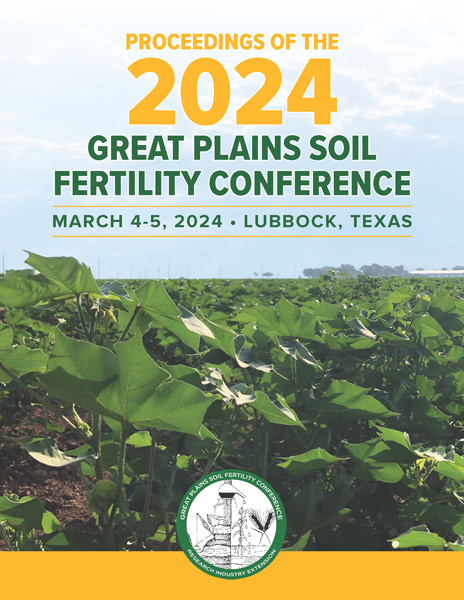Conference Proceedings Available!
Proceedings
Authors
| Filter results9 paper(s) found. |
|---|
1. Nitrogen Managememt in Dryland Winter Wheat to Improve Grain Yield and ProteinMaximizing the yield along with adequate protein content in winter wheat is an emerging challenge for dryland wheat producers. Proper nitrogen (N) management with optimization of fertilizer application rate and timing might be a potential strategy to improve grain yield and protein. The objective of the study was to evaluate the effects of different N rates and application timing on grain yield and protein content of hard red winter wheat in Nebraska. Field study was carried out at four locations... D. Ghimire, B. Maharjan |
2. Utilizing Long-term Organic Amendments to Improve Soil Health in Semi-arid, Grazed GrasslandsDetermining soil health changes associated with long-term land application of organic amendments, such as biosolids, is important for understanding and improving overall environmental health. In 1991, a single application of biosolids were surface applied (treatment rate: 0, 2.5, 5, 10, 21, or 30 Mg ha−1) to a semi-arid grazed grassland. In 2002, a repeated application of biosolids were surface applied at the same rate to ½ of all plots. In 2018, soil samples were obtained from 0-15... C. Buchanan, J. Ippolito |
3. Snapshot of Crop Nutrient Balance with Use of a Rye Cover Crop in a Corn-soybean Rotation Under Tile Drainage in Eastern South DakotaThe purpose of this study was to evaluate the effect of using a winter rye cover crop within a corn/soybean rotation (rye seeded every fall and burned down each spring) on drainage water quality, crop nutrient status, and grain yield. Use of a winter rye cover crop to take up available N from the soil profile is a management tool that may help to lessen nutrient movement out of the soil profile while at the same time contributing to improved soil health. Winter rye is very winter hardy... P. Sexton, S. Kumar, S. Osborne, B. Brockmueller, A. Bly, B. Rops, A. Bawa, S. Bauder, J. Mcmaine |
4. Effect of Soil and Foliar Application of Sulfur, Magnesium, Boron, and Zinc on Root Yield and Sugar Quality in Conventional Till and No Till Sugar BeetField experiment was conducted at the Eastern Agricultural Research Center in Sidney, MT, to determine the effect of S, Mg, B, and Zn on beet yield and sugar quality under conventional and no-till system. Split-plot design was used with 3.6 x 9.1 m experimental plots and four replicates. Tillage was main plot and micronutrient fertilizer was sub-plot. Tillage treatments included conventional and no-till. Fertilizer treatments included SUL4R-PLUS® (Ca & S), SUL4R-PLUS®B+Zn... C. Lim, C. Chen, C. Kowatch-carlson, B. Franck, T. Gross, R. Brown |
5. Sugarbeet Yield Response and Nitrate Leaching As Influenced by Nitrogen Management in Semi-arid ClimateFertilizer nitrogen (N) in irrigated sugarbeet production needs to be optimized to simultaneously increase yield and reduce nitrate leaching. In addition to adjusting N rate and application timing, there are available fertilizer technologies such as controlled- or slow-release N which may be beneficial for beet yield and reducing potential nitrate leaching. However, there are limited studies assessing the effectiveness of such fertilizers for sugarbeet in a semi-arid climate. The two-year experiment... D. Ghimire, B. Maharjan |
6. Effect of Seeding Rate on Annual Warm Season Forage Yield and Plant StructureDue to the decline of the Ogallala Aquifer and reduced irrigation capacity, there is growing interest in more water-efficient cropping systems in the semi-arid central Great Plains. To support the region’s livestock industry, there is increased interest in forages because they use water more efficiently than grain crops. However, there is insufficient information on summer annual forage seeding rates in the range of environments encountered in the region. The objective of this study was... J. Holman, N. Detter, A. Obour, P. Tamea |
7. Summer Annual Legumes: Yield Potential and Water UseDue to the decline of the Ogalla Aquifer and reduced irrigation capacity, there is a growing interest in more water-efficient cropping systems in the semi-arid central Great Plains. One of the most water-intense crops grown on the semi-arid central Great Plains is alfalfa (Medicago sativa L.). Alfalfa is grown for its nutritive value and protein, which is highly desired by cow/calf, feed yards, and dairies of the central and southern Great Plains. The purpose of this study was to evaluate... J. Holman, N. Detter, A. Obour, L. Haag, K. Roozeboom |
8. Effect of Extractant pH on Exchangeable Cation Determination Using Ammonium Acetate and Mehlich-3Neutral pH ammonium acetate (1N NH4OAC, pH 7.0) is a standard soil test extractant for exchangeable cation concentrations. However, the concentrations may be artificially inflated for alkaline soils, especially those that are highly calcareous. The same effect potentially occurs with the Mehlich-3 extractant (Meh3, pH 2.5). The objective of this study was to determine the effect of pH on exchangeable base cation soil test concentrations. Soil samples from the High Plains region were randomly... F. Vocasek, B. Hopkins |
9. Experience with Using the Sikora-2 Soil/buffer pH Method in the Great PlainsThe acreage of acidic soils in the Great Plains continues to increase from long-term cropping and fertilizer nitrogen use. Acidic soils developed initially in dryland fields and/or in areas dominated by sandy soils, but are now relatively common in irrigated systems and finer-textured soils. A typical method used in the Great Plains states had been to determine soil pH in a 1:1 soil:water slurry and, when required, to determine exchangeable acidity using the SMP buffer solution. The buffer pH... F. Vocasek, S. Harrold |
